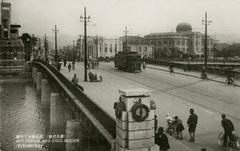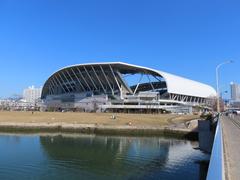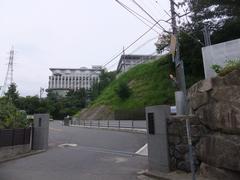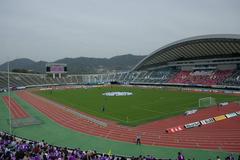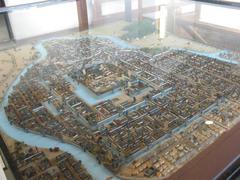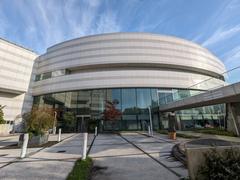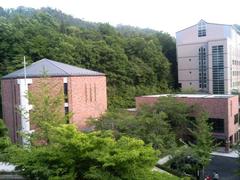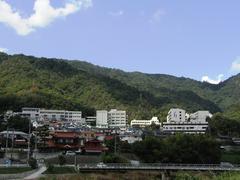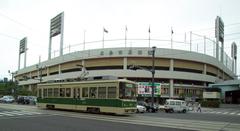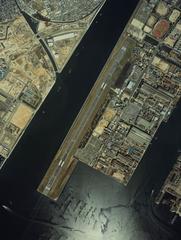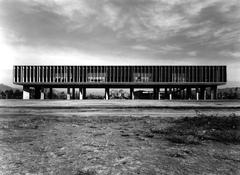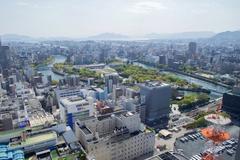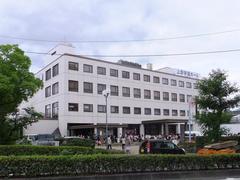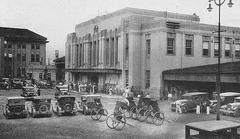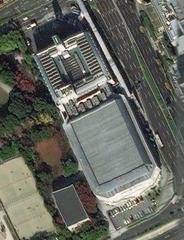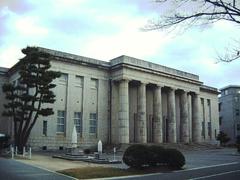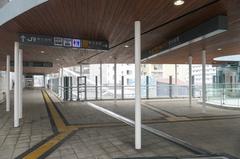
Assumption of Mary Cathedral Hiroshima: Visiting Hours, Tickets, and Historical Significance
Date: 04/07/2025
Introduction
The Assumption of Mary Cathedral—also known as the Memorial Cathedral for World Peace (世界平和記念聖堂, Sekai Heiwa Kinen Seidō)—stands in central Hiroshima as a profound symbol of resilience, reconciliation, and hope. Rising from the ashes of atomic devastation, this cathedral is not only an architectural landmark designed by Togo Murano but also a living memorial dedicated to the victims of the atomic bombing on August 6, 1945. Its unique blend of Western and Japanese design, spiritual ambiance, and central location near other Hiroshima peace sites make it a must-visit destination for those seeking to understand the city’s journey from tragedy to peace.
Table of Contents
- Historical Background
- Architectural Features
- Visiting Information
- Visitor Experience
- FAQs
- Conclusion
- References and Further Reading
Historical Background
Origins and World War II Destruction
The original Catholic church in Hiroshima’s Noboricho district was destroyed in the atomic bombing on August 6, 1945 (archeyes.com). Father Hugo Enomiya-Lassalle, a German Jesuit missionary and atomic bomb survivor, led the devastated Catholic community. Inspired by the need for healing and remembrance, he envisioned a new cathedral as both a place of worship and a beacon for world peace (dive-hiroshima.com).
Reconstruction and Vision for Peace
Construction began on August 6, 1950—exactly five years after the bombing—supported by international donations and the Vatican (dive-hiroshima.com). Contributions included bells cast from former German weapons and mosaics from West Germany, symbolizing global reconciliation (japantravel.com). Architect Togo Murano designed the building, merging Western ecclesiastical forms with Japanese aesthetics, and using bricks containing ashes from the bombing to memorialize the city’s tragic history (archeyes.com).
Dedication and Cultural Recognition
The cathedral was completed and dedicated on August 6, 1954. In 2006, it was designated an Important Cultural Property by the Japanese government for its historic and architectural significance (dive-hiroshima.com).
Architectural Features
Exterior and Symbolism
- Austere Modernism: The cathedral’s solemn concrete exterior reflects the gravity of Hiroshima’s history (Japan Tourism Agency).
- Japanese-Western Fusion: Visitors approach via a bridge and a wooden torii-inspired gate, which blends Christian and Shinto symbolism (Peace Tourism).
- Phoenix Rooftop: Replacing the traditional cross, a phoenix symbolizes rebirth and hope (Japan Tourism Agency).
- Memorial Bricks: The bell tower incorporates bricks made with earth containing atomic bomb ashes, creating a poignant connection to the city’s past.
Interior Elements and Artistic Details
- Main Sanctuary: The nave features high ceilings, a black marble altar donated by Belgium, and a mosaic of Christ carrying the cross—a gift from West Germany.
- Stained Glass: Windows depict Japanese flora, including bamboo, pine, and plum, symbolizing resilience and renewal (Peace Tourism).
- Lotus Flower Lamps: Honoring Buddhist donors, these lamps highlight the cathedral’s inclusive and interfaith spirit (Japan Tourism Agency).
- Artistic Details: Sculptures by Kenji Imai represent the Seven Sacraments, and local woodwork and exposed concrete blend Japanese craftsmanship with modernist design.
- Pipe Organ: A pipe organ from Germany enhances the spiritual ambiance during services (Japan Experience).
Visiting Information
Hours and Admission
- Opening Hours: Typically open daily from 7:00 AM to 8:00 PM (Trip.com).
- Admission: Free; donations are appreciated to support ongoing upkeep and peace initiatives.
Accessibility and Facilities
- Wheelchair Access: The main sanctuary and garden are accessible, with ramps and suitable pathways.
- Multilingual Services: Mass is celebrated in several languages, including Japanese, English, Portuguese, Spanish, Vietnamese, and Tagalog (Japan Experience).
- Photography: Permitted in most areas; please avoid flash and remain respectful during services.
- Facilities: Restrooms, English-language brochures, and benches are available; some areas like the crypt may have limited accessibility.
Directions and Transportation
- Address: 4-42 Nobori-cho, Naka-ku, Hiroshima.
- From Hiroshima Station: Approximately a 10-minute walk southwest or via Hiroshima Electric Railway (tram) to Kanayama-cho or Noboricho stops (Japan Experience).
- Nearby: Walking distance from Hiroshima Peace Memorial Park and the Atomic Bomb Dome.
Visitor Experience
Atmosphere and Services
Visitors are greeted by the cathedral’s austere façade and tranquil gardens. Inside, soft lighting filtered through stained glass and the international character of the pipe organ create a contemplative, welcoming environment. The main sanctuary is spacious, while a side chapel and peaceful garden offer further opportunities for reflection.
Special Events and Nearby Attractions
- Annual Ceremonies: Peace ceremonies, especially on August 6, and interfaith events are held throughout the year.
- Nearby Sites: Include the Hiroshima Peace Memorial Park, Hiroshima Castle, Hondori shopping street, and the Hiroshima Museum of Art.
- Guidebooks: A detailed guidebook is available for purchase (approx. 500 yen), providing historical and artistic insights.
Tips for a Meaningful Visit
- Allocate 30–60 minutes to explore the cathedral and its grounds.
- Combine your visit with other Hiroshima historical sites for a richer understanding of the city’s peace heritage.
- Attend a multilingual Mass for a unique experience.
- Respect the sacred atmosphere by maintaining silence, dressing modestly, and asking before photographing inside the sanctuary.
FAQs
What are the cathedral’s visiting hours?
Open daily from 7:00 AM to 8:00 PM.
Is there an admission fee?
No; entry is free, though donations are welcomed.
Are guided tours available?
Regular tours are not offered, but multilingual brochures and helpful staff are available.
Is the cathedral accessible for wheelchair users?
Yes, the main areas are accessible; contact the cathedral for specific needs.
Can I attend Mass in English or other languages?
Yes, Mass is celebrated in multiple languages.
Conclusion
The Assumption of Mary Cathedral is far more than a place of worship—it is a living monument to peace, resilience, and intercultural harmony. From its memorial bricks to the phoenix on its rooftop, every detail embodies Hiroshima’s journey from tragedy to hope. With free admission, accessible facilities, and a welcoming environment, it invites all visitors to reflect on the past and embrace a vision for a peaceful future. Pair your visit with Hiroshima Peace Memorial Park and other nearby sites for a comprehensive exploration of the city’s legacy.
For further information and travel updates, refer to official sources and mobile apps such as Audiala, or connect with local tourism offices. Embrace the opportunity to witness a unique intersection of history, architecture, and peace advocacy in the heart of Hiroshima.
References and Further Reading
- Explore the Assumption of Mary Cathedral in Hiroshima: A Symbol of Peace and Resilience (Dive Hiroshima)
- Visiting the Assumption of Mary Cathedral in Hiroshima: History, Tickets, and Travel Tips (Joy in Hiroshima)
- Memorial Cathedral for World Peace: Hours, History, and Highlights (Peace Tourism and Japan Tourism Agency)
- Memorial Cathedral of World Peace Hiroshima Visitor Guide (Japan Experience)
- Assumption of Mary Cathedral - Hiroshima Tourism
- Hiroshima Peace Memorial Park Official Site
- archeyes.com - World Peace Memorial Cathedral
- Japan Travel - Cathedral That Rose from the Ashes
- Trip.com - Assumption of Mary Cathedral
- Peace Tourism
- Evendo - Assumption of Mary Cathedral
- cpap.hiroshima-diocese.net - Official Cathedral Site
- Nobori-cho Catholic Church Official Site

